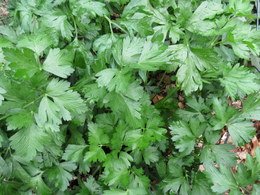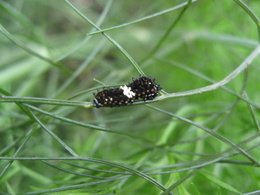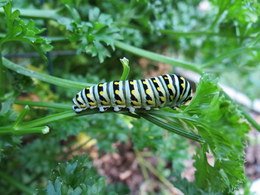Parsley Growing Guide
Parsley (Petroselinum crispum) is a popular culinary herb used by chefs for flavor in many dishes and salads as well as a decorative garnish.
The flat leafed Italian parsley is preferred by chefs for its easy chopping and flavor. The curled leaf variety is highly decorative as a garnish as well as in cooking.
It is a biennial that is usually grown as an annual. In USDA zone 7 and warmer, it will survive the winter and flower the second growing season, but it tastes better the first season.
Parsley can be easily grown in containers outdoors as well as indoors in a very sunny window or under grow lights.
Starting From Seed
Parsley seeds can be started indoors 6 to 8-weeks before your last expected frost date. Sow thinly and cover with 1/8-inch of soil. The seeds look like very small caraway seeds. Many gardeners find that parsley may take 3 to 4-weeks to germinate or very poorly.
The seeds germinate best with the use of a seed starting heat mat. The seeds need to be warm and kept moist for them to germinate. Watering with lukewarm water, not warmer than 105-degrees F, will help speed up the process.
For more detailed information visit the seed starting page.
Soil Preparation
Parsley likes a nice loose well-drained garden soil. Add compost and blend in before planting. It prefers full sun, but can tolerate some light shade, especially during the hot summer weather. Soil pH should be 5.5 to 6.7.
As soon as the soil is frost-free and can be worked, till the soil by digging down 8 to 12-inches turning the soil over with a garden fork. Remove any large rocks and stones that are 1 to 2-inches in size. The small stones remaining will do no harm and actually benefit the soil by adding some micronutrients to the soil.
Planting Parsley
Plant it in full sun to part sun in the garden after all danger of frost. The planting depth is very important. It should be planted deep enough for the roots to be covered by the soil, but do not bury the crown, which is the growing bud. The new growth comes from the center of the root crown. The plant may rot and die if planted too deeply.
The average plant will grow about 12-inches wide and 12-inches tall and can be spaced 12-inches apart.
Water the newly planted plants daily to keep the roots from drying out for the first week or so. After the roots get established and you see a lot of new growth emerging you can taper off to a good watering once a week.
Watering and Care
When the plants are a few inches tall add a nice loose mulch of shredded leaves or pine straw to shade the plant roots. This will keep the weeds out, the soil cooler and help retain moisture. Keep the mulch a couple of inches away from the stem. During dry spells give some water each week.
Harvesting Parsley
Carefully remove the lower outer leaf stems with snips or scissors. Be careful that you do not tug too hard and disturb the roots. Leave the new growth in the center to continue to grow and mature.
Established parsley is very frost tolerant down to the low 20-degree range and will continue to grow. Depending on your growing zone you may be harvesting up to and perhaps past Christmas.
A light row cover can be used to cover your plants overnight to give some protection on the heavier frost nights.
Drying Parsley
During the summer you are likely to be harvesting more than you need for your daily use. Your surplus can be dried and stored to use during the winter months. Parsley can be air dried, oven dried or through the use of a food dehydrator.
The traditional way is to air drying, but you need to be in a warm, dry climate for the drying to occur quickly. For most locations air drying will not work very well.
The fastest and easiest way is the oven method and with the oven set at the lowest warm setting will dry the parsley in an hour or two. If you have a food dehydrator, then follow its instructions.
For oven drying a large cookie sheet will give good results. To avoid having to pick out a lot of stems it is better not to dry them in the first place. Carefully pull or pinch the leaves from the stems and place the leaves in a thin layer on a cookie sheet. A thin layer will dry faster and more evenly giving better results.
Check from time to time to see if the leaves are dry enough to be stored. If the parsley crinkles between your fingers, then it is ready. If it does not, then it will need more time.
Drying is a great way to extend the harvest for use during the winter. A glass jar such as a Mason jar with a tight fitting cap is the best way to store your dried parsley. A jar of dried parsley will also make a great gift for Christmas or another special occasion.
The same method will work for basil, dill and other herbs. You should store your dried herbs in an airtight container in a dark location.
Diseases and Pests
Parsley is generally free of diseases and pests. Occasionally if it is too crowded, leaf spot caused by the Septoria fungus and blight caused by the Botrytis fungus may occur. It should have plenty of sunlight and air circulation to avoid problems. Crown/root rot may also occur if the soil is kept too wet. Keeping the leaves dry by using a drip line or watering the soil is the best way to prevent problems.
Parsley is one of the host plants of Black Swallowtail butterflies and is a good addition to your herb garden as well as a flower garden or wildlife garden. Other host plants include carrots, dill, fennel, and Queen Anne’s lace. Plant some extra parsley for the caterpillars; they do not do much damage, so leave them alone and enjoy them.
A newly hatched caterpillar is black with a white saddle around its middle and looks very much like a bird dropping. They are very small and you may not notice it until it gets to be 1/8 to 1/4-inch long. As it grows it will shed its skin and turn into an attractive stripped caterpillar.
Each molting stage is called an instar and it will go through 5-instars getting larger each time. Then it will leave the parsley and attach itself to a twig where it will enter the chrysalis stage looking very much like a part of the twig. In 2 to 3-weeks a beautiful Black Swallowtail butterfly will emerge. There are some amazing YouTube videos of the process.
The first instar of the Black Swallowtail caterpillar.
The later stage of the Black Swallowtail caterpillar.
Popular Parsley Varieties
Curled: Moss curled, Tripled curled, Favorit, Antaris, Wega, Paravert
Flat: Italian, Fidelio, Titan, Giant of Italy
Sources: Seeds Now, Burpee, Johnny’s Selected Seeds
Garden Spikes newsletters give you timely information once or twice a month. Subscribe Free to the Garden Times newsletter below.
Your email address will only be used to send you a newsletter and will never be sold. You can unsubscribe at any time.



